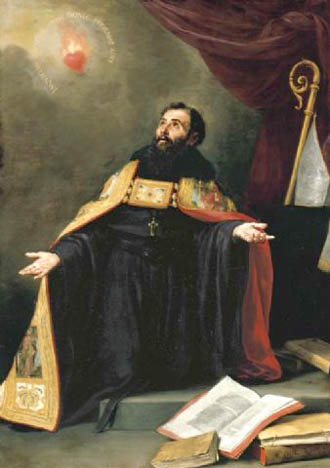Monday, May 16th, 2005...9:24 pm
New Spring for Old Masters

Bartolome Esteban Murillo, Saint Augustine in Ecstasy
This spring New York Old Masters’ sales at Sotheby’s and Christie’s complement each other in historical periods and artists’ nationalities.
After brokering the sale of Duccio’s Stroganoff Madonna now at the Metropolitan Museum Christies has put together an illustrious group of paintings for its May 26 sale. Murillo’s Extasis de San Agustin illustrates the emotionalism, tenebrism, and naturalism of the Spanish Baroque. The saint’s open arms, upward gaze, and facial expression establish his dialogue with Zurbaran and Jose de Ribera. The theatrical use of light confirms the date of this painting to the 1640s. Jordaens’ Flight into Egypt, a favorite topic of the Flemish Baroque, is a reminder of Rubens’ several takes on the subject. The Death of Seneca is the work of Giambattista Tiepolo, an artist that wielded enormous power in Enlightenment Spain under Carlos III.
Jean-Honore Fragonard is generally known for his Frick series. Christie’s oil study for Jupiter and Callisto gives the viewer a glimpse into his working methods, use of light, application of color, and creation of environment. The two lots by Pieter Breughel Jongere represent a dialogue with his father’s Wedding Feast. The younger painter’s Wedding Feast (one in at the Irish National Gallery) and Peasants Giving Gifts to the Bride, caricaturesque, are not as moralistic and condemnatory as his father’s eponymous work.
Francesco Guardi is a contemporary of Canaletto and Bernardo Bellotto. His Chiesa di S. Giovanni e Paolo at Christie’s shows the atmosphere and emotion of an early Canaletto. The work represents a different perspective of the same subject depicted by Bellotto in 1741.
Sotheby’s offering is remarkable for its samples of trecento and quattrocento Italian religious painting. The Norton Madonna and Child with Saints Anthony Abbot and Saint Bernardino by Sano di Pietro exhibits a notable dichotomy: the Madonna’s hieratic, formulaic face and the Child’s naturalistic depiction. Sano di Pietro’s oeuvre appears at the Louvre and the Kress Collection Lowe Art Museum. The examples of Sienese art at Sotheby’s attest to the city’s sophisticated visual concern with delicacy and ornamentation. Standing Male Saint by Benedetto di Bindo offers further evidence of Siena’s continuing hold of its Italo-Byzantine idiom. Jacopo del Landini (his works appear at the Boston MFA and the Kress Collection) relates to Cimabue and ignores the naturalistic expression of Maso di Banco and Taddeo Gaddi, working in Florence at the same time. Landini’s opus disregards Ambrogio Lorenzetti, the link between Siena and Florence While Bicci di Lorenzo worked in his Crucifixion, for sale at Sotheby’s, Masaccio and Donatello (perhaps even Fra Filippo Lippi) were already active in Florence. His artistic activity took place within the context of a family workshop (son of Lorenzo di Bicci, father of Neri di Bacci). This work is proof of the Early Renaissance conflict between iconographic tradition and revolution.
A notable Van Dyck portrait, Ferdinand de Boisschot, Baronet of Saventheum is a deep psychological study of the subject more than an exercise in aristocratic portraiture. A truly intriguing piece comes up for sale at Sotheby’s: the Persian School’s Portrait of a Nobleman. An XVII century work confirms the Safavid’s court cosmopolitan refinement. Grace, attention to detail, and exposure to Western art are evident in the piece. European visual aesthetics arrived in Isfahan with its aperture to trade, patronage and Armenian influence. Portrait of a Nobleman is a fascinating pastiche.
The spring Old Masters sales at Sotheby’s and Christie’s come at a time when important collectors and marchands are already in New York for the yearly International Fine Arts and Antiques Fair.




2 Comments
February 15th, 2007 at 6:40 am
Spring Old Masters sales is over, but we need every year sales not only in NY.
July 7th, 2007 at 4:51 pm
Though I am not an art collector and neither a practicing artist but my academic background in the find arts remain strong. Will continue to visit this blog. Keep it coming please…
most effective acne solution